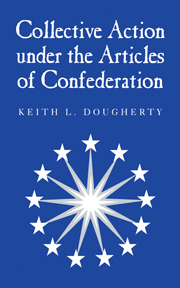Book contents
- Frontmatter
- Contents
- List of Tables and Figures
- Acknowledgments
- 1 The Mystery of State Contribution
- 2 National Interests and State Sovereignty: Objectives of the Confederation
- 3 Collective Action and the Provision of Public Goods
- 4 The History of State Compliance
- 5 State Contributions and Private Interests
- 6 Reacting to Rebellion
- 7 A New Constitution
- 8 Conclusion
- Appendix: Olson's Collective Action Game
- Glossary
- References
- Index
3 - Collective Action and the Provision of Public Goods
Published online by Cambridge University Press: 15 October 2009
- Frontmatter
- Contents
- List of Tables and Figures
- Acknowledgments
- 1 The Mystery of State Contribution
- 2 National Interests and State Sovereignty: Objectives of the Confederation
- 3 Collective Action and the Provision of Public Goods
- 4 The History of State Compliance
- 5 State Contributions and Private Interests
- 6 Reacting to Rebellion
- 7 A New Constitution
- 8 Conclusion
- Appendix: Olson's Collective Action Game
- Glossary
- References
- Index
Summary
Not a shilling has been put into the Continental Treasury, but by the utmost reluctance. The probable delinquency of other States has been the pretext for non-compliance with every State.
– Edmund RandolphThe framers of the Articles of Confederation adopted the system of requisitions to divide the cost of common state interests and to facilitate the production of collective goods. They believed centralized purchasing agents could acquire supplies more effectively than thirteen separate state agencies and requested states to pool their monies in order to facilitate national purchasing. Centralized purchasing helped the nation coordinate its military policy, improved accountability, and strengthened the nation's bargaining position with suppliers. It was more effective than supplying thirteen armies separately. Even though the system of requisitions may have provided effective purchasing and enabled a unified command, it did not give the states any reason to contribute to the national treasury. Instead, Congress depended on legal obligations and external incentives to obtain contributions from the states. This left the states purchasing public goods as if they were in an institution-free setting.
This chapter analyzes the collective action problem under the Articles of Confederation and the amount of contribution we should expect from the states. It does this by first developing a theory of pure public goods based on Mancur Olson's Logic of Collective Action. It is shown that typically one, or no, state should contribute to the provision of a public good as opposed to the privileged group that Olson described.
- Type
- Chapter
- Information
- Collective Action under the Articles of Confederation , pp. 34 - 50Publisher: Cambridge University PressPrint publication year: 2000



